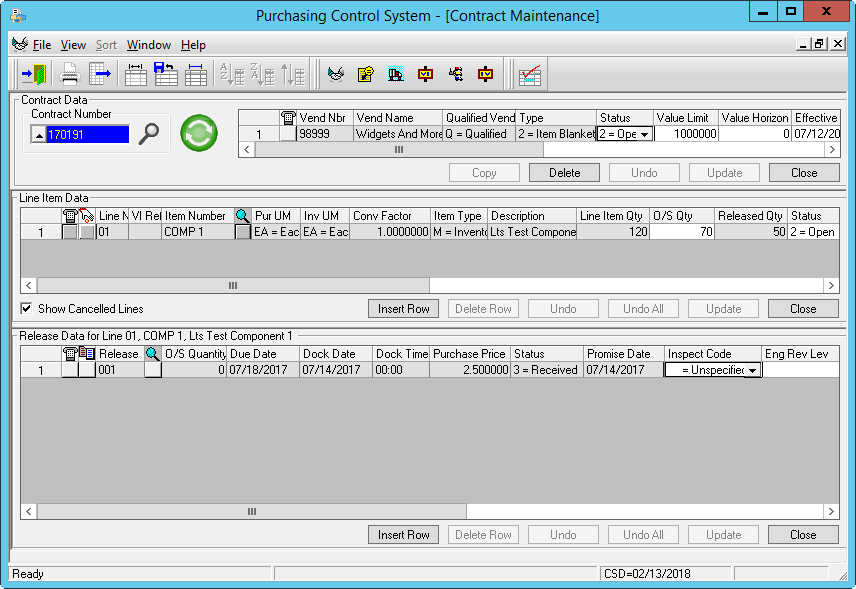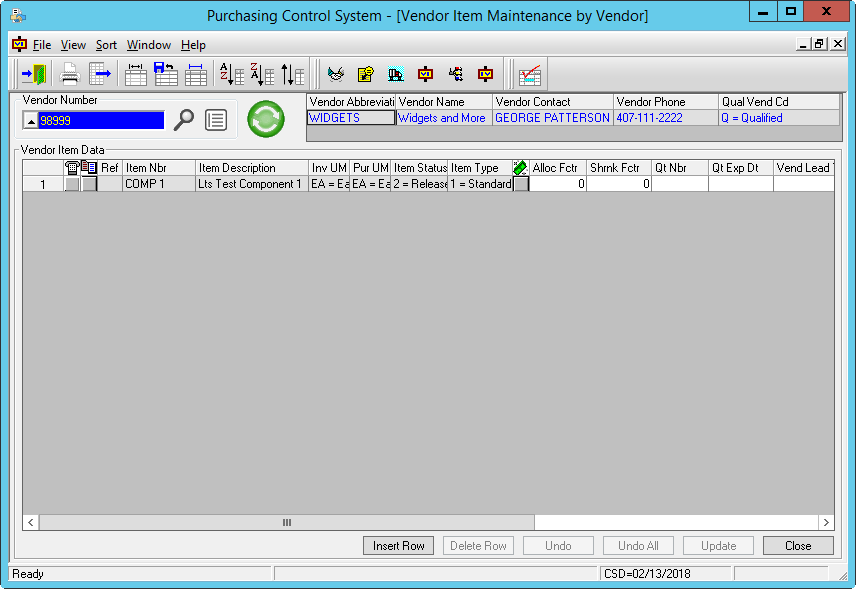The Purchasing Control System (PCS+PLUS) manages the entire range of purchasing functions, from initial vendor sourcing, to contract placement and order release and finally through the receiving and inspection processes. PCS+PLUS works in conjunction with Planner+PLUS and MRP+PLUS to monitor the execution of the purchasing portion of the materials plan.
Of special interest to regulated companies is the vendor and vendor-item qualification system. A vendor may be in any of three statuses. A vendor may be unqualified. This status indicates that the vendor has not yet been certified. A status of Qualified indicates that the vendor qualification or requalification process was completed satisfactorily. A status of Unqualified indicates that the vendor may not be used as a supplier.
Qualification solely by vendor assumes that everything supplied by the vendor is either Qualified or Unqualified. AMAPS+PLUS adds another more precise level of control. This level enables you to set the status of Qualified, Unqualified or Disqualified based by the item supplied by the vendor. Just because an item is causing problems does not, in and of itself, mean that all the items supplied by that vendor are problematical.
PCS+PLUS, furthermore, enables you to identify the preferred vendor and preferred manufacturer. The preferred vendor is the supplier that you want to use. The preferred manufacturer indicates that regardless of the vendor this manufacturer should produce this product.
- Multiple purchase order types
- Buying groups
- Flexible purchasing policies
- Non-inventoried items
- Free-form text
Multiple Purchase Order Types
Cost effective purchasing requires maximum flexibility, particularly in placing orders. To provide this flexibility, PCS supports the following purchase order contract types:
- Order/requisition
- Item blanket
- Dollar blanket
- Option agreement
Additionally, to further tailor the system to your environment, PCS supports both single and multiple line item orders and single and multiple delivery line items for each order type.
Order/Requisition. This order type, sometimes referred to as a single-buy contract or purchase order, is used when you wish to create a purchase order to cover one or more purchase requisitions in full or in part. The order specifies items, quantities, prices, due dates, and authorizes delivery.
Item Blanket. This order type supports the basic blanket ordering concept. The item blanket order allows you to contract for one or more items at quoted prices and quantities over a specified time period. Delivery authorization is deferred until shipping releases are issued to cover your purchase requisitions.
Dollar Blanket. This order type is an extension of the blanket ordering concept. It is an advanced purchase of vendor capacity that will be used when shipping releases are issued to cover supply requisitions. Only a dollar ceiling and agreement period are specified on the dollar blanket order. Specific parts, quantities, and delivery dates are identified with each shipping release.
Option Agreement. This type of order is another extension of the blanket ordering concept. The option agreement specifies one or more items at a ceiling price. Delivery authorization and quantity are deferred until shipping releases that cover purchase requisitions are issued within a specified period. At the end of the agreement period according to terms and conditions set forth in the contract, the actual price paid is based on quantity delivered.
Buying Groups
All buyers want the highest quality products for the lowest cost. However, buying decisions are often made without considering the impact of other items in relation to the one being purchased. You can sometimes obtain price concessions by purchasing several related items from a single vendor.
PCS+PLUS gives you the capability of categorizing your purchased items into buying groups. If an item in a buying group is to be purchased, the buyer is automatically notified of any other group members open for purchase, based on user-specified options. If the buyer decides to place an order for another item belonging to the buying group, PCS+PLUS also creates a placed order for it, even if it was not yet requisitioned by MCS+PLUS. MRP+PLUS will then make any necessary planned requisition adjustments to the material plan.
Flexible Purchasing Policies
To support your unique purchasing operations, PCS+PLUS enables you to define the policy and control information needed to effectively manage the purchasing function within your environment. This information includes:
- Vendor selection policies
- Single/multiple line-item-per-purchase-order policies
- Receipt control policies
- Buyer target prices
- Purchase order follow-up points
- Standard purchase order terms and clauses
- Performance reporting controls
- Text for notes, specifications, and special instructions
Free-Form Text
PCS+PLUS provides the capability to maintain and display free form, unformatted information for use on any of your formal purchasing documents. All text elements, such as vendors, purchase orders, and parts, have a unique identifier that can be referred to from other data structures, so the cross filing and indexing normally associated with manual files is eliminated. Using this technique, PCS+PLUS meets your requirements for standard text clauses as well as other notes, reminders, and subjective information, to help improve communication.
Non-Inventoried Items and Services
You can designate an item as:
- Inventoried
- Non-inventoried
- Service
Inventoried items are the purchase materials you define in the Item Master and then plan, track, and control through MRP+PLUS, MCS+PLUS, and PCS+PLUS. For example, the receipt of an inventoried part causes corresponding PCS+PLUS and MCS+PLUS updates.
Non-inventoried items and services are defined only in PCS+PLUS. Orders for non-inventoried items and services are fully managed within the purchasing system, with the triggering of demands independent of MRP+PLUS.
Cash Commitments Analysis
Cash commitments analysis projects the effect of price variances into the future and measures the cash flow requirements necessary to meet future obligations. Based on released orders and MRP planned orders, PCS+PLUS extends purchases by actual, standard, target and last-buy costs. PCS+PLUS then plots these extended costs over time within user-specified horizons. Reports provide both buyer and vendor detail and summary recaps which list totals by period, buyer, and vendor. Using Ask AMAPS, you can perform on-line retrievals of cash commitments by buyer, vendor, item or buying group.
Summary
The Purchasing Control System gives purchasing professionals needed tools to do their jobs better and more efficiently. Everyone involved in the purchasing cycle, from individuals generating requisitions to the receiving personnel benefits from reduced paperwork and improved visibility and control.

